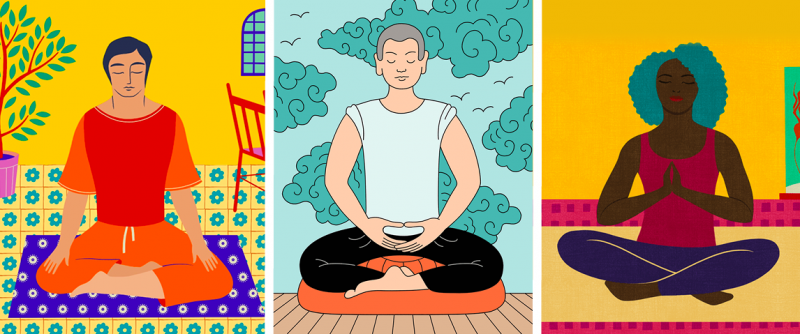Part I
About 22 years ago, when I offered my first meditation class at the Swedenborg Chapel in Cleveland, Ohio, one of the first questions was, “what is meditation?” These days, meditation has become very popular; so much so that even children in elementary schools practice it! Personally, I love this mindfulness movement, because however we approach meditation, when we practice, there is an actual benefit for our mental and physical health.
I also support the way people use the term “meditation,” and choose to practice it in whichever way it works for them. Yet, it could be worthwhile to reflect on the term “to meditate,” and to know what it means in English, Sanskrit, and Chinese. I am specifically lifting these three languages primarily because the first practice of meditation was most likely developed by people who used Sanskrit. Additionally, the popular Buddhist meditation practices in the West originated from the Chinese Zen Buddhistic tradition. Interestingly, English is a language from the west, Chinese is from the east, and Sanskrit – from India – is between the two. Given the cultural differences between these traditions, there seem to be very different understandings about what it means to meditate.
The English word “to meditate” is from a Latin word meditari (meaning measure) which then became meditate- (meaning contemplate). From this root, the English word meditate came into use in about the mid-16th century. Today, according to an English dictionary, to meditate means to think deeply or carefully about something, to plan mentally, or to consider. What the English word seems to emphasize is that a meditation is a mental exercise or practice for an efficient and effective judgment or conclusion.
The Sanskrit word for meditate is dhyana, meaning to have a meditative practice, which is a deeper concentration of the mind with breath control and mental focus. What the Sanskrit word seems to emphasize is the importance of creating a proper balance in mind and body so that one’s mind can find a calm state of concentration.
The ancient Chinese word “to meditate” is zen, which is a combined word of two others: one is the word for see – as in vision – and the other is the word meaning one or only one. Roughly, the Chinese word zen could mean the practice of seeing the only one (Buddha nature) within. What the Chinese word seems to emphasize is that meditation is a practice to achieve a state of being where one could clearly see the unchangeable nature within oneself.
There is the fourth place we find the word mediate: the Bible. One example is in Joshua 1:18, “This book of the law shall not depart out of your mouth; you shall meditate on it day and night, so that you may be careful to act in accordance with all that is written in it. For then you shall make your way prosperous, and then you shall be successful.” The Hebrew word to meditate is hagah, meaning to moan, growl, utter, speak, or muse. According to James Strong’s Exhaustive Concordance of the Bible, hagah appears in the Old Testament about 24 times, and translates to meditate only five times. However, what seems to be common among all these five possible meanings of hagah is that this word is definitely about getting the full attention of someone or toward someone or something. Thus, “you shall meditate on it day and night” means to have your full attention to it all the time, meaning keep this in your mind and never forget it. In a way, this could be close to another famous practice: mindfulness.
 Part II
Part II
The common thread between the different approaches of the East and West is that there was a shared acknowledgement among ancient people about the psychological and cognitive practice that could enhance their life. The type of enhancement might differ from one tradition to another and one individual to another, but what they were aiming to cultivate was the same: the mind. Also, arguably there was a shared understanding of how easily the mind could be influenced by either an outside event or source, or something from within such as an emotion or feeling. One last shared understanding that I find significant is that they seemed to agree on one thing: when the mind is calm and clear, we can see matters and issues as they are, and thus are enabled to make a more thoughtful and rational decision. This definitely could lead those who practice meditation to a life with calm, peace, and fulfillment.
Among nearly all meditation practices, there is one thing that is emphasized as the foundational practice: breath control or breathing practice. According to modern research, our brain uses about 20% of our body’s total oxygen. Thus, when our brain does not get enough oxygen, we may develop one or some of these symptoms: temporary memory loss, reduced ability to move the body, difficulty paying attention, or difficulty making sound decisions. Also, when the brain is not getting enough oxygen, a degree of malfunctioning – severity depending on the rate of deficiency – could be expected. Therefore, getting enough oxygen to our body, especially to our brain, is very important! The very first step of breathing practice is normally set up for this purpose.
Many people have asked, “how do I start meditation?” Some seem to understand that meditation is just sitting down with the eyes closed, but it’s a bit more involved than that. In my understanding, if you would like to practice meditation for real, you would need to create a healthy balance of your body and mind. What this means is that you need to make your body and mind capable of entering into the state of meditation before you can begin. If you would like to start or restart a practice, here are three steps that I recommend before you engage in meditation. First, you need to spend about 5-15 minutes doing a whole-body stretch. This helps the muscles relax and the blood to circulate more effectively. Second, you need to sit down and make yourself comfortable for about 5-10 minutes. This will situate your mind to the present moment and the task that you would like to do. Third, practice breathing for about 5-15 minutes. At this time, you simply focus on your breath; first without controlling anything, then later gently guiding your breathing to become longer and deeper. Only after this preparation will you be ready to engage in a beneficial meditation practice.
 Part III
Part III
One last clarification, meditation is designed neither for relaxation nor for mental enhancement for better performance. Of course, as a result of meditation your mind and body could become more relaxed with a possible gain of mental enhancement. But from the point of view of Hinduist yogis to Buddhist monks, meditation was and still is a form of both mental and spiritual exercise to obtain one thing: enlightenment. Why? They firmly believed that the physical reality in which we are living is not true reality, and thus it may be penetrated. The biggest problem that they perceive is our own mind which acknowledges physical reality as the one true reality. The practice of meditation, therefore, was developed in order to break through this illusion created by our own mind, and thus to reach the true reality embedded within our mind. The point here is that you need a clear and specific goal or purpose when practicing meditation.
Now, if you are prepared and ready, let’s talk about what to do during meditation. There are many types and forms in the world and in general, they all have their own advantages and disadvantages. However, the most important thing is not what kind of practice you do, but how regularly you do it. There are three types of meditation that I practice daily, the first being breathing meditation. This is the oldest and most simple. All you need to do is to count your breath and remember your counting. After completing a whole cycle of in- and exhalation, you count one. When your count becomes ten, you note it mentally as a set. You could make a goal of completing 5, 7, 10 or even 20 sets.
The second type of meditation is mental defragmentation. I am not sure other people are doing this, but I started this practice in 1994 after defragmenting my computer for the first time. You may want to complete 5 or 7 breathing sets before you engage in this meditation because it requires inner focus and stability. The mechanism is quite similar to the defragmentation done in computers. First, you search your mind and identify fragmented thoughts and emotions. Then, you process them by noticing their existence followed by a mental acknowledgement of what they are, why they are, and how you want to manage them.
The third form of meditation I practice is a meditative lifestyle. As stated previously, meditation is not just something you do sporadically for relaxation or mental enhancement. To truly experience the benefits of meditation, you might want to bring calmness and mindfulness into your life in general. At any given moment, the human mind is anything but calm and mindful. Thus, in order to bring calmness and mindfulness, we need to remember the importance of practicing them persistently!
My friends and family in God, these days I do meditation as a preparation before I enter a deeper state of prayer, which is nothing but a deep connection and communication with God. I hope that you find meditation practice useful for your spiritual cultivation, and practice it daily.
Blessings, Rev. Junchol Lee

